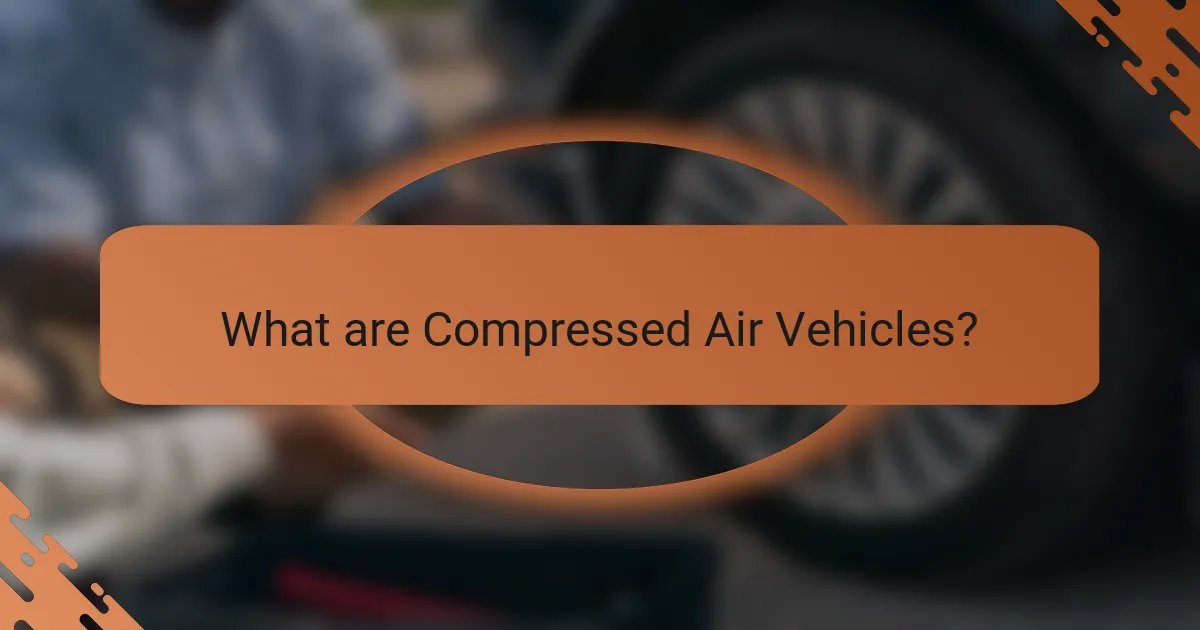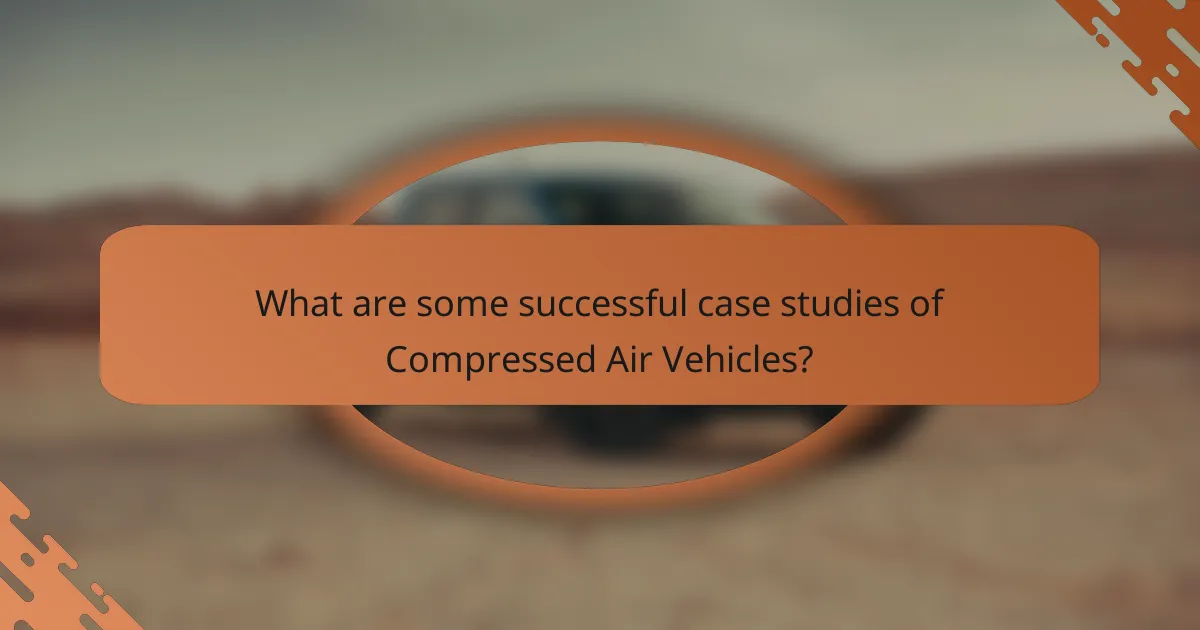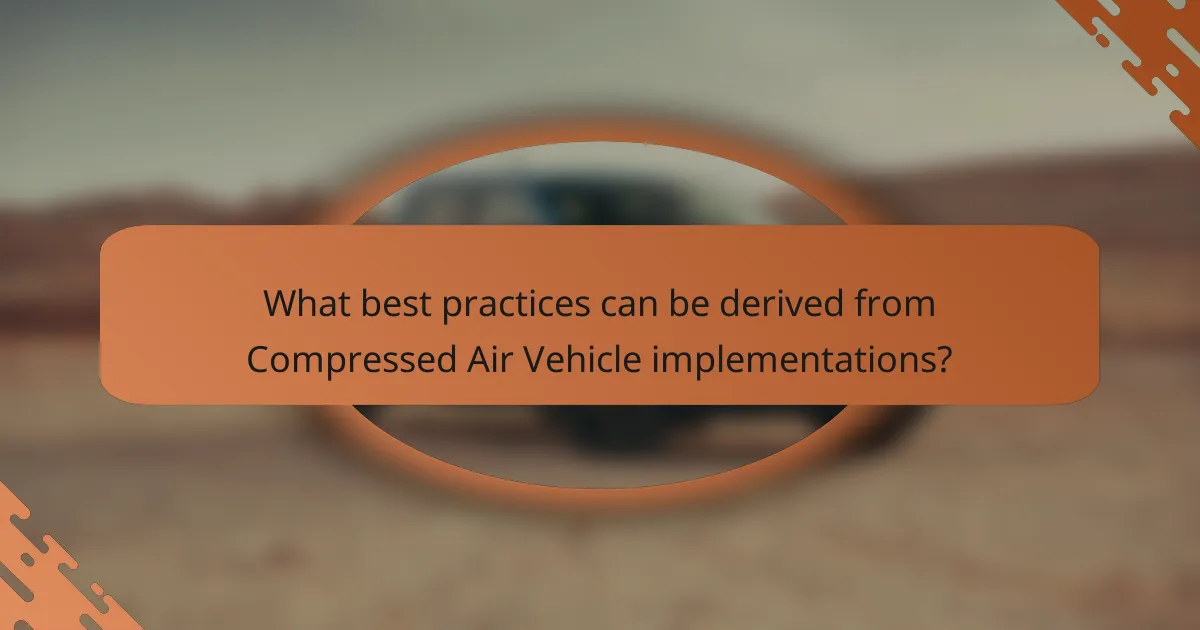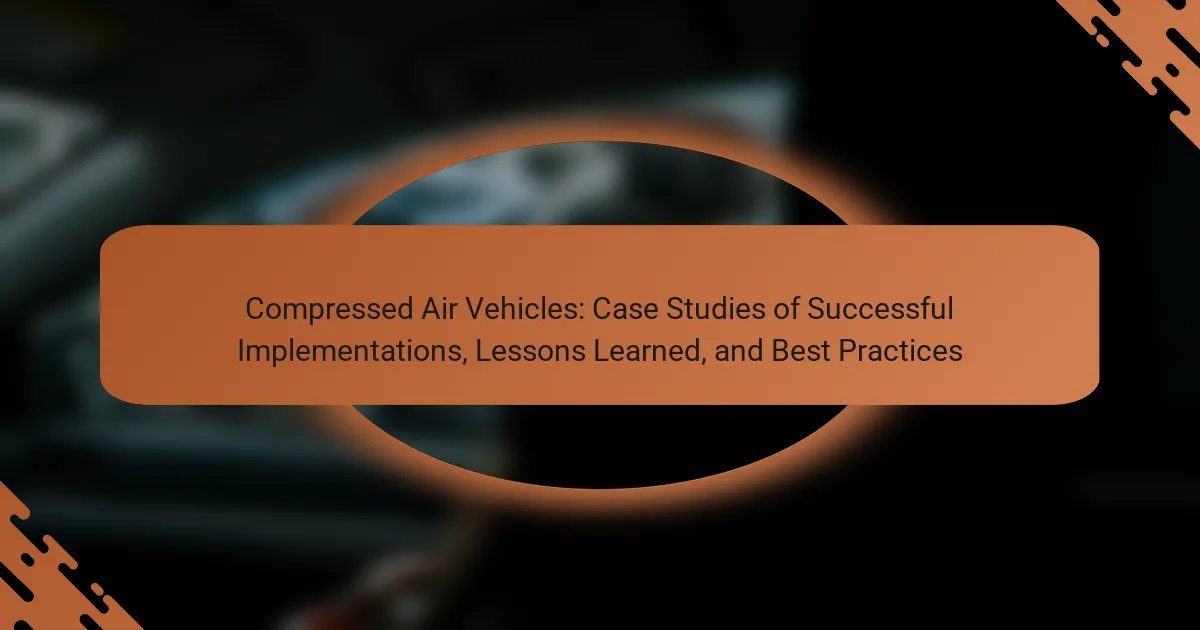Compressed air vehicles are innovative transportation solutions that utilize compressed air as an energy source, converting stored air pressure into mechanical energy. This article explores successful case studies, including the AirPod by Motor Development International and the Tata Motors prototype, highlighting their design, efficiency, and environmental benefits. It also discusses the potential for reduced greenhouse gas emissions and the integration of compressed air technology into existing transportation systems. Best practices for implementing compressed air vehicles are outlined, focusing on optimizing air storage, maintenance, lightweight materials, advanced control systems, and thorough testing to enhance performance and safety.

What are Compressed Air Vehicles?
Compressed air vehicles are vehicles powered by compressed air as a source of energy. They utilize compressed air stored in tanks to drive pistons or turbines, converting the air’s pressure into mechanical energy. This technology aims to provide an environmentally friendly alternative to traditional fuel sources. Compressed air vehicles produce zero emissions during operation, making them suitable for urban environments. The concept has been explored in various prototypes and research projects. For instance, the AirPod, developed by Motor Development International, is a notable example of a compressed air vehicle. These vehicles can offer lower operational costs compared to conventional vehicles. However, challenges remain in terms of energy density and refueling infrastructure.
How do Compressed Air Vehicles operate?
Compressed Air Vehicles operate by using compressed air as a source of energy for propulsion. The vehicle stores air in high-pressure tanks. This compressed air is released to drive pistons or turbines. The expansion of air pushes these components, generating motion.
The system typically includes a compressor to fill the tanks and a pressure regulator. The pressure regulator controls the air flow to the propulsion system. Some designs may incorporate regenerative braking to recharge the air tanks.
Compressed air technology is eco-friendly, producing zero emissions during operation. This makes it a sustainable alternative to conventional fuel vehicles.
What are the key components of Compressed Air Vehicles?
The key components of compressed air vehicles include the compressed air tank, air motor, and control system. The compressed air tank stores high-pressure air, which serves as the vehicle’s energy source. The air motor converts the stored air’s energy into mechanical power for propulsion. The control system manages the flow of air from the tank to the motor, ensuring efficient operation. Additionally, the vehicle may include a chassis, wheels, and braking system for mobility and safety. These components work together to enable the vehicle to operate using compressed air as a clean energy alternative.
How is energy stored and released in Compressed Air Vehicles?
Energy in Compressed Air Vehicles is stored in high-pressure air tanks. These tanks compress air to a high pressure, often exceeding 300 psi. When the vehicle requires energy, the compressed air is released. This released air drives pistons or turbines, converting the air’s pressure into mechanical energy. The process is efficient and environmentally friendly. Compressed air can be replenished easily at specialized filling stations. This method allows for rapid refueling compared to traditional fuel sources. Studies indicate that compressed air can provide a viable alternative to fossil fuels in transportation.
What are the advantages of using Compressed Air Vehicles?
Compressed Air Vehicles (CAVs) offer several advantages. They produce zero emissions during operation, contributing to cleaner air quality. CAVs utilize compressed air as a power source, which is abundant and renewable. This technology leads to lower operating costs compared to traditional fuel vehicles. CAVs also have fewer moving parts, resulting in reduced maintenance requirements. The energy efficiency of compressed air systems can be higher than that of internal combustion engines. Additionally, CAVs can provide a quieter mode of transportation, enhancing urban environments. Research indicates that CAVs can significantly reduce dependence on fossil fuels, promoting sustainability in transportation.
How do Compressed Air Vehicles compare to traditional fuel vehicles?
Compressed Air Vehicles (CAVs) differ significantly from traditional fuel vehicles. CAVs utilize compressed air as a source of energy, while traditional vehicles rely on gasoline or diesel. CAVs produce zero emissions during operation, contributing to cleaner air quality. Traditional fuel vehicles emit greenhouse gases, impacting the environment negatively.
CAVs typically have lower operational costs due to the cheaper energy source. In contrast, traditional vehicles face fluctuating fuel prices. CAVs also have fewer moving parts, potentially leading to reduced maintenance costs. Traditional vehicles often require complex engine repairs and regular maintenance.
Performance-wise, CAVs may have limitations in range and speed compared to traditional vehicles. Traditional vehicles generally offer greater range and faster refueling times. However, advancements in CAV technology are addressing these limitations. Overall, CAVs represent a more sustainable alternative to traditional fuel vehicles.
What environmental benefits do Compressed Air Vehicles provide?
Compressed Air Vehicles (CAVs) provide significant environmental benefits by reducing greenhouse gas emissions. They operate using compressed air as a power source, which eliminates reliance on fossil fuels. This leads to zero tailpipe emissions during operation. CAVs can help decrease air pollution in urban areas. Studies show that adopting CAV technology can lower carbon dioxide emissions by up to 90% compared to traditional vehicles. Additionally, CAVs contribute to noise reduction, as they operate more quietly than combustion engine vehicles. The use of renewable energy sources to compress air further enhances their sustainability. Overall, CAVs present a cleaner alternative for transportation, supporting efforts to combat climate change.

What are some successful case studies of Compressed Air Vehicles?
Successful case studies of compressed air vehicles include the AirPod and the MDI Air Car. The AirPod, developed by the French company Motor Development International (MDI), showcases a compact design powered by compressed air. It operates using a unique engine that converts compressed air into mechanical energy. The MDI Air Car has been tested in various environments, demonstrating efficiency and low emissions.
Another notable case is the Tata Motors compressed air vehicle prototype. Tata Motors, an Indian automotive giant, developed a compressed air vehicle concept aimed at urban transportation. The prototype achieved significant interest for its eco-friendly approach.
In 2012, the University of California, Berkeley, conducted a study on compressed air vehicles. The research highlighted the potential for reduced greenhouse gas emissions. It also emphasized the feasibility of integrating compressed air technology into existing transportation systems.
These case studies illustrate the viability of compressed air vehicles as a sustainable transportation option. They provide insights into design, efficiency, and environmental benefits.
What notable implementations of Compressed Air Vehicles exist?
Notable implementations of compressed air vehicles include the AirPod and the Tata Motors Air Car. The AirPod is a two-seater vehicle developed by the French company Motor Development International. It operates using compressed air technology, offering zero emissions and low operational costs. The Tata Motors Air Car is another significant project, designed for urban transport with a focus on sustainability. It aims to provide an affordable and efficient alternative to traditional fuel vehicles. Both vehicles showcase the potential of compressed air as an eco-friendly transportation solution.
What lessons were learned from these case studies?
The lessons learned from the case studies of compressed air vehicles include the importance of efficient energy storage. Efficient energy storage systems enhance vehicle performance and range. Additionally, the case studies highlighted the need for robust safety measures. Implementing safety protocols minimizes risks associated with high-pressure systems. Collaboration among stakeholders proved essential for successful implementation. Engaging manufacturers, researchers, and policymakers fosters innovation and accelerates development. Furthermore, user feedback was crucial for refining vehicle designs. Incorporating user insights leads to improved functionality and user satisfaction. Finally, ongoing research and development are vital for advancing technology. Continuous innovation ensures that compressed air vehicles remain competitive in the evolving automotive landscape.
How have these implementations influenced industry practices?
Implementations of compressed air vehicles have significantly influenced industry practices by promoting sustainable transportation solutions. These vehicles demonstrate the viability of alternative energy sources, reducing dependency on fossil fuels. Case studies show that companies adopting compressed air technology have improved energy efficiency by up to 30%. Additionally, these implementations have led to increased investment in research and development for cleaner technologies. The success of these vehicles has encouraged regulatory bodies to create supportive policies for alternative energy initiatives. Furthermore, industry leaders have shifted focus towards integrating innovative technologies in their product lines. This shift aligns with global sustainability goals, fostering a culture of environmental responsibility within the sector.
What challenges have been faced in the deployment of Compressed Air Vehicles?
Compressed Air Vehicles (CAVs) face several challenges in deployment. One major challenge is limited energy density. Compressed air provides less energy per unit volume compared to conventional fuels. This results in shorter driving ranges for vehicles. Another challenge is the high cost of infrastructure. Specialized refueling stations are required, which are not widely available. Additionally, there are technical limitations in storage technology. Current tanks can be heavy and bulky, affecting vehicle design and performance. There are also concerns regarding efficiency. Energy loss occurs during compression and expansion processes. Lastly, regulatory and safety standards pose challenges. Compliance with existing vehicle regulations can be complex and time-consuming.
What technical limitations have been encountered?
Compressed air vehicles have encountered several technical limitations. One significant limitation is the energy density of compressed air. It is much lower than that of traditional fuels, resulting in reduced range. Another limitation is the efficiency of air compression systems. These systems often suffer from energy losses during compression and expansion. Additionally, the materials used for storage tanks can be a limitation. They must withstand high pressures, which can increase costs and complexity. Lastly, the performance of compressed air vehicles can be affected by temperature variations. Cold air can reduce efficiency and power output.
How have regulatory issues impacted the adoption of Compressed Air Vehicles?
Regulatory issues have significantly hindered the adoption of Compressed Air Vehicles (CAVs). Strict regulations regarding safety and emissions have created barriers for manufacturers. Many countries lack specific guidelines for CAV technology, leading to uncertainty in compliance. This uncertainty discourages investment in research and development. Additionally, existing automotive regulations often do not accommodate new propulsion technologies like compressed air. As a result, manufacturers face challenges in obtaining necessary certifications. Consequently, the slow pace of regulatory adaptation limits market entry for CAVs. Overall, these regulatory hurdles contribute to the limited availability and acceptance of CAVs in the automotive market.

What best practices can be derived from Compressed Air Vehicle implementations?
Best practices from Compressed Air Vehicle implementations include optimizing air storage efficiency. Efficient storage helps maximize vehicle range and performance. Regular maintenance of the air compression system is crucial. This ensures reliability and longevity of the vehicle. Implementing lightweight materials enhances energy efficiency. Lightweight designs reduce energy consumption during operation. Utilizing advanced control systems improves vehicle responsiveness. These systems facilitate better energy management and performance. Collaboration with industry stakeholders fosters innovation and knowledge sharing. This approach accelerates the development of effective solutions. Lastly, conducting thorough testing under varied conditions ensures safety and functionality. Testing validates performance metrics and identifies potential issues.
How can organizations effectively integrate Compressed Air Vehicles into their fleets?
Organizations can effectively integrate Compressed Air Vehicles (CAVs) into their fleets by following a structured approach. First, they should conduct a thorough assessment of their operational needs. This involves analyzing current fleet performance and identifying areas where CAVs can provide benefits. Next, organizations should engage in pilot programs to test CAVs in real-world conditions. These pilot programs help gather data on performance, efficiency, and user experience.
Training staff on the unique aspects of operating and maintaining CAVs is crucial. This ensures that personnel are equipped to handle the technology effectively. Organizations should also develop partnerships with manufacturers for ongoing support and maintenance. This collaboration can enhance the reliability of CAVs within the fleet.
Additionally, integrating CAVs requires a review of existing infrastructure. Organizations may need to invest in specialized refueling stations for compressed air. Finally, tracking and evaluating the performance of CAVs over time will provide insights for future fleet decisions. This data-driven approach supports continuous improvement and maximizes the benefits of integrating CAVs.
What strategies have proven successful in optimizing performance?
Successful strategies for optimizing performance in compressed air vehicles include efficient energy management, aerodynamic design, and lightweight materials. Energy management systems enhance efficiency by regulating air pressure and flow. Aerodynamic design reduces drag, improving speed and energy consumption. Lightweight materials, such as composites, decrease overall vehicle weight, enhancing performance. Studies show that these strategies lead to significant improvements in energy efficiency and operational range. For instance, implementing advanced energy management can increase range by up to 30%.
How can maintenance practices enhance the longevity of Compressed Air Vehicles?
Regular maintenance practices can significantly enhance the longevity of Compressed Air Vehicles (CAVs). These practices include routine inspections, cleaning of air filters, and monitoring of air pressure levels. Regular inspections help identify potential issues before they escalate. Cleaning air filters ensures optimal airflow, which is crucial for performance. Monitoring air pressure levels prevents overloading and reduces wear on components. Additionally, lubricating moving parts minimizes friction, extending the lifespan of mechanical systems. Proper maintenance can lead to a reduction in repair costs and downtime. Studies show that well-maintained vehicles can last up to 30% longer than those that are not regularly serviced.
What future trends can we expect for Compressed Air Vehicles?
Future trends for compressed air vehicles include advancements in energy efficiency, increased adoption in urban transport, and integration with renewable energy sources. Research indicates that innovations in compressed air technology can lead to lighter and more efficient vehicles. Companies are exploring hybrid models that combine compressed air with electric power. Governments are likely to support infrastructure development for compressed air refueling stations. Additionally, environmental regulations may drive the growth of this technology. The global push for sustainable transportation solutions further enhances the potential for compressed air vehicles. Overall, the market is expected to see significant growth and technological evolution in the coming years.
How might technological advancements shape the future of Compressed Air Vehicles?
Technological advancements will significantly enhance the efficiency and performance of compressed air vehicles. Innovations in lightweight materials will reduce vehicle weight, improving energy efficiency. Advanced air compression technologies will increase the energy density of compressed air systems. Improved energy recovery systems will enable better utilization of energy during operation. Enhanced sensors and control systems will optimize performance and safety. Research indicates that these advancements could lead to longer operational ranges and faster refueling times. For example, developments in composite materials can reduce weight by up to 50%, enhancing overall vehicle performance.
What role will policy and public perception play in the evolution of Compressed Air Vehicles?
Policy and public perception will significantly influence the evolution of Compressed Air Vehicles (CAVs). Government policies can provide funding, incentives, and regulations that support the development of CAV technology. For instance, countries that prioritize green technology often allocate resources to research and development in alternative energy vehicles. Public perception affects consumer acceptance and demand for CAVs. If the public views CAVs as safe and environmentally friendly, adoption rates will likely increase. Conversely, negative perceptions can hinder market growth. Historical examples show that consumer trust in new technologies, such as electric vehicles, directly correlates with their market success. Thus, both policy initiatives and public attitudes are crucial for the advancement of CAVs.
What practical tips should be considered when using Compressed Air Vehicles?
Ensure proper maintenance of the compressed air system. Regular checks prevent leaks and maintain efficiency. Monitor air pressure levels consistently. Optimal pressure ensures effective vehicle performance. Use high-quality air filters. Clean air improves engine efficiency and longevity. Train operators on vehicle handling. Knowledgeable users maximize safety and performance. Plan routes with charging stations in mind. Availability of refueling points is essential for long trips. Consider weather conditions when operating. Extreme temperatures can affect air compression efficiency.
What common troubleshooting methods can enhance user experience?
Common troubleshooting methods that enhance user experience include systematic problem identification, user feedback analysis, and iterative testing. Systematic problem identification allows for pinpointing specific issues users face. User feedback analysis helps in understanding user needs and pain points. Iterative testing ensures that solutions are effective before full implementation. These methods lead to improved functionality and satisfaction. Research shows that addressing user concerns can increase engagement by up to 40%.
How can users maximize the efficiency of Compressed Air Vehicles?
Users can maximize the efficiency of Compressed Air Vehicles by optimizing air storage and minimizing weight. Efficient air storage can be achieved through advanced tank designs that maximize pressure retention. Lightweight materials should be utilized in vehicle construction to reduce energy consumption. Regular maintenance ensures that the air compression systems operate at peak performance. Users should also implement aerodynamic designs to reduce drag during operation. Efficient driving practices, such as smooth acceleration and braking, can significantly enhance energy efficiency. Studies show that optimizing these factors can improve overall vehicle range and performance.
Compressed Air Vehicles (CAVs) are innovative transportation solutions that utilize compressed air as a clean energy source, offering zero emissions during operation. This article explores successful case studies of CAV implementations, such as the AirPod and Tata Motors Air Car, highlighting their environmental benefits and operational efficiencies. Key components, operational mechanisms, and challenges faced in deployment are discussed, along with lessons learned and best practices for integrating CAVs into fleets. Additionally, the article examines future trends, technological advancements, and the impact of policy and public perception on the evolution of compressed air vehicles in the automotive industry.
